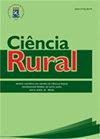Anatomical characterization of black wattle wood for the pulp and paper production
IF 0.9
4区 农林科学
Q3 AGRONOMY
引用次数: 0
Abstract
ABSTRACT: The growing worldwide demand in the pulp market has fostered research that evaluates alternative fiber sources with specific characteristics that attend the needs of the consumer market, with a view to add value to the final product and reduce production costs. Acacia mearnsii De Wild wood is a by-product of the extraction of tannin from the trunk bark, used for firewood, charcoal and pellets. However, its wood is still poorly studied, especially its anatomical characteristics, which can provide important information about its industrial potential. This study evaluated the anatomical characteristics of Acacia mearnsii wood for the production of pulp and paper. Ten trees at approximately seven years old were cut down, five from the seed production area (SPA) and five from the clonal population area (CPA). From each tree, one trunk disc was sectioned at the diameter at breast height (DBH), resulting in 10 (ten) wood samples. From each disc, a sapwood specimen was made oriented in the tangential longitudinal, radial longitudinal and transversal planes, for later obtaining the anatomical cuts and the macerates. The anatomical description of the wood followed the recommendations of the International Association of Wood Anatomists-IAWA. From the dimensions of the fibers, their quality evaluation ratios for the production of pulp and paper were calculated. Results obtained from the anatomical characterization allowed to conclude that the Acacia mearnsii woods from SPA and CPA are indicated as a source of raw material for the pulp and paper production.纸浆和造纸用黑荆树木材的解剖特性
摘要:全球纸浆市场需求的不断增长,促进了对具有特定特性的替代纤维来源的研究,以满足消费市场的需求,从而增加最终产品的价值并降低生产成本。野生金合欢木材是从树干树皮中提取单宁的副产品,用于木柴、木炭和颗粒。然而,对其木材的研究仍然很少,特别是其解剖特征,这可以提供有关其工业潜力的重要信息。本研究评估了用于制浆造纸的金合欢木材的解剖学特征。10棵7岁左右的树被砍倒,5棵来自种子生产区(SPA), 5棵来自无性系种群区(CPA)。从每棵树上,按胸径(DBH)对一个树干圆盘进行切片,得到10(10)个木材样本。在每个圆盘上,制作一个沿切向纵向、径向纵向和横切面方向的边材样本,以便稍后获得解剖切口和浸渍物。木材的解剖描述遵循了国际木材解剖学家协会- iawa的建议。从纤维的尺寸出发,计算出用于制浆造纸的纤维质量评价比。从解剖特征中获得的结果表明,SPA和CPA的金合欢木材是纸浆和纸张生产的原料来源。
本文章由计算机程序翻译,如有差异,请以英文原文为准。
求助全文
约1分钟内获得全文
求助全文
来源期刊

Ciencia Rural
AGRONOMY-
CiteScore
1.70
自引率
0.00%
发文量
233
审稿时长
2-4 weeks
期刊介绍:
The purpose of Ciência Rural is to publish the results of original research, note and reviews which contribute significantly to knowledge in Agricultural Sciences. Preference will be given to original articles that develop news concepts or experimental approaches and are not merely repositories of scientific data. The decison of acceptance for publication lies with the Editors and is based on the recommendations of Editorial Comission, Area Committee and/ or ad hoc reviewers. The editors and reviewers are external to the institution.
 求助内容:
求助内容: 应助结果提醒方式:
应助结果提醒方式:


